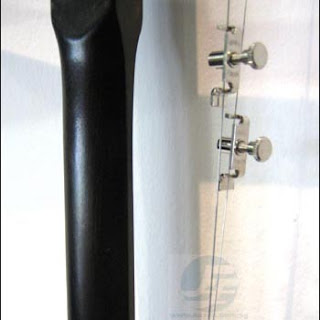Unfortunately, only the starter grade Erhus are fitted with bronze tuning mechanisms. The intermediate and above models all comes with wooden pegs. So what do you do if you just cannot get to the centre of your AP tuner?
Enter the fine adjusters.
Type 1: China made fine adjusters

They work by hooking the string and pulling the string towards the fine adjuster. Works fine but some users said the screw on the adjuster sometimes screws up. What do you expect a screw to do anyway?
Type 2: Wittner made fine adjusters

Wittner is a German company famous for its music stands and string instruments' tail pieces. Their fine adjusters are made of better materials and work by pushing the string away from the adjusters. Some users commented that it often breaks the string. But I think they push it till the string bends at a right angle. Don't turn it so much and you'll be fine.
Type 3: Do-it-yourself(DIY) fine adjusters

Just take a piece of qianjing string and loop it once around the neck, and once around the string above the qianjing. Tie it somewhere near the qianjing to start off. Adjust the pitch by moving the DIY fine adjuster up and down. Good for purists who don't want any metallic stuff on their Erhu. A bit flimsy though.
So that's all folks.
But for your information I never use fine adjusters on my personal Erhu...
Update: Some commented that the metallic fine adjustors eats bow hairs if you're not careful. Thought I'll leave a note about this here.
Ah Boy had those string adjusters put on by his erhu teacher on his erhu when he first started learning erhu last yr. I never realised how to make use of those until much later. *haha*
ReplyDeleteAfter much prodding from his CO teacher, we let him buy those metal fine tuners, and I told his erhu teacher abt it. Small issue, lah. But greatest peeve with it is that unless the boy is very very careful, these fine tuners are a pain to have to deal with in keeping the erhu in the case. It *eats* bow hairs if not extremely careful. *AARGH*! And it's difficult for a small boy to be very extra careful with it when the erhu is half his size.
Thanks for your comment the chengs.
ReplyDeleteThe eating bow hair part is very true. The fine adjusters can get entangled with the bow hairs if you're not careful when storing the bow.
Oh, I forgot to ask - why is the bronze-adjusting pegs only for beginner erhus?
ReplyDeleteThe bronze might give a metallic aftertone to the instrument, thus players will not want to 'taint' the sound of their good Erhus with that.
ReplyDeleteMoreover, good players desiring a good Erhu should have no problems with wooden pegs.
I like the extra qianjin string idea. I often find my bow hair gets caught in the fine tuners when in the case.
ReplyDeletehey there...nice blog...very useful information here..notice that most sco musicians use the third kind of adjusters..the qian jin one..in my opinion..looks more professional as well??? xD
ReplyDeleteThanks Anonymous. Yes I noticed Singapore Chinese Orchestra musicians like to use the string qianjing as well.
ReplyDeletePerhaps you can leave your name the next time so I know who I am talking to.
How do you use the bronze tuing just out of curiosity ^_^? Do you turn the pegs like normal?
ReplyDeleteas tuning an erhu
ReplyDelete